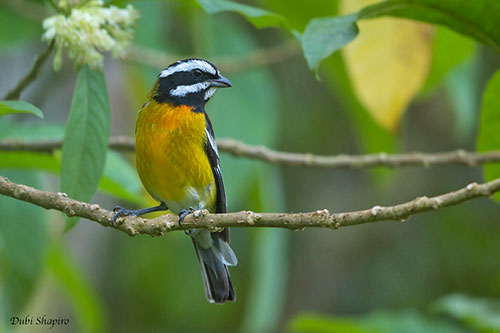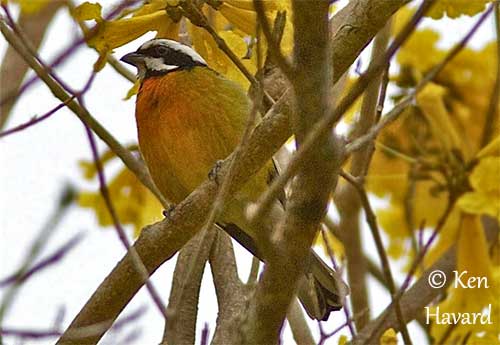
Fr: Zéna de la Jamaïque
Ang: Jamaican Spindalis
All: Jamaika-Streifenkopftangare
Esp: Cigua Jamaicana
Ita: Spindalis della Giamaica
Nd: Jamaicaanse Spindalis
Sd: jamaicaspindalis
Photographers:
Ken Havard
My Bird Gallery & Flickr gallery 1 & Flickr gallery 2
William Price
PBase-tereksandpiper & Flickr William Price
Dubi Shapiro
Dubi Shapiro Photo Galleries
Text by Nicole Bouglouan
Sources:
HANDBOOK OF THE BIRDS OF THE WORLD Vol 16 by Josep del Hoyo- Andrew Elliot-David Christie – Lynx Edicions – ISBN: 9788496553781
A Photographic Guide to the Birds of Jamaica De Ann Haynes-Sutton, Yves-Jacques Rey-Millet, Audrey Downer, Robert Sutton – Editeur: Bloomsbury Publishing, 2010 – ISBN: 1408133229, 9781408133224 – 336 pages
Neotropical Birds – Cornell Lab of Ornithology
Jamaican Spindalis
Spindalis nigricephala
Passeriformes Order – Thraupidae Family
INTRODUCTION:
The Jamaican Spindalis is endemic to Jamaica where it frequents forests, woodlands and brushy areas at middle and high elevations. It feeds on fruits, berries, flowers and leaves, and forages in pairs, in family groups or in mixed-species flocks in the canopy. It nests in a loose cup-shaped structure placed in tree or bush.
The Jamaican Spindalis has currently stable population in Jamaica, and the species is not globally threatened.
The genus Spindalis is confined to the Greater Antilles, but there is also a population on Cozumel Island. Formerly, only one species was recognized, the Striped-headed Tanager, with height subspecies. Now, the genus is split into three monotypic species (Jamaican Spindalis, Hispaniolan Spindalis and Puerto Rican Spindalis) and the Western Spindalis with five subspecies. They differ in morphology, plumage and vocalizations.

DESCRIPTION OF THE BIRD:
Biometrics:
Length: 18 cm
Weight: 38-65 g
The Jamaican Spindalis is the largest species of this genus.
The brightly-coloured male has yellow-olive back, becoming orange on rump and uppertail-coverts. On the upperwing, flight-feathers and coverts are black with white edges. The tail is black with white-edged outer rectrices.
On the underparts, the central breast is yellowish-orange, becoming yellow on lower breast and belly. Vent, thighs and undertail-coverts are white. Flanks and body sides are tinged greenish-yellow.
On the head, we can see a black hood contrasting with a broad, white supercilium extending to side of nape, and a long, broad white malar stripe. Chin and upper throat are white and bordered with black.
The two-tone bill is thick and the lower mandible is silver with dark tip. The eyes are dark brown. Legs and feet are dark grey.

The female is much duller than the male, with greyish-olive head, throat and upperparts. The facial pattern is indistinct or absent. On the upperwing, the inner flight-feathers and the greater wing-coverts are edged white.
On the underparts, central breast is pale orange-yellow, belly is mostly pale yellow whereas undertail-coverts are whitish.
The juvenile resembles female but it is duller, with indistinct head pattern. Wings and tail are dark grey with yellow edges. The back is greenish-grey, becoming yellowish on the rump.
RANGE:
The Jamaican Spindalis is found only in Jamaica.
HABITAT:
The Jamaican Spindalis frequents wet forests and woodlands from sea-level to mountains. It prefers areas with fruiting trees in forest and at forest edges.
CALLS AND SONGS: SOUNDS BY XENO-CANTO
The Jamaican Spindalis is more often heard than seen. Its high, thin calls are commonly heard in Jamaican forests.
It gives a soft, weak “seep” in flight. While foraging in groups, they produce a fast, high “chi-chi-chi-chi-chi”.
The male sings from exposed perches and gives churrs or rattles when threatened or disturbed. The song is a long-sustained phrase repeated several times “chu wheet, chee see whee see, chu wheet”.
BEHAVIOUR IN THE WILD:
The Jamaican Spindalis feeds mainly on fruits and berries from various plant species, and fruits of Ficus, Cecropia and Dunalia, but also oranges, pimentos and Roystonea fruits are part of its diet. It also consumes nectar, flowers, blossoms and leaves.

They often feed in pairs and family groups, but also in loose mixed-species flocks. They roam the canopy while searching for food and often hang from twigs and leaves to take berries. They grasp plants with the bill and swing from one to another without help of wings or feet.
The breeding behaviour in poorly known, but the breeding season is closely related to food abundance.
The Jamaican Spindalis is resident in Jamaica.
The flight is agile, but this species only performs short-distance flights.
REPRODUCTION OF THIS SPECIES:
The breeding season takes place from April to July.
The Jamaican Spindalis builds a loose cup-shaped nest with grass and rootlets, placed in bush or tree.
The female lays 2-3 greenish-white to pale grey eggs with darker markings towards the larger end.
No more information.
PROTECTION / THREATS / STATUS:
The Jamaican Spindalis has restricted range in which it is described as common and widespread, although it is more local on N and SW coasts. It is mainly found at high elevations.
The population is currently stable and the species is not globally threatened.
The Jamaican Spindalis is currently evaluated as Least Concern.